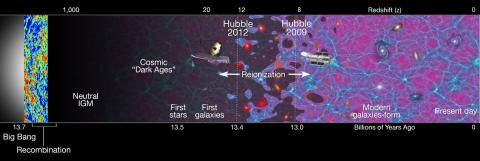
Hubble Ultra Deep Field 2012 Press Image: Cosmic History

This illustration depicts cosmic history, from the Big Bang approximately 13.7 billion years ago (starting from the left) until the local universe today (far right). A detailed description of the illustration follows after the break.
Inititally, after the Big Bang the Universe was hot and dense but expanding. As it expanded, the temperature of gas in the universe cooled to the point where free electrons (negatively charged particles) could recombine onto protons (the positively charged particles that comprise atomic nuclei) to "recombine" to form neutral hydrogen. This event, called Recombination occurred roughly 370,000 years after the Big Bang (at a "redshift" of z~1100) and left behind an electrically neutral Intergalactic Medium (IGM). This event also released the radiation that we see today as the cosmic microwave background (CMB).
Immediately after Recombination, there were no stars or galaxies in the universe. Without sources of light the universe existed in what we call the "Cosmic Dark Ages". However, overtime the dark matter and gas in the universe could form bound objects through gravity. As the gas in these objects became dense, they could form the first stars. We think these first stars formed at or around redshift z~20, or about 100-200 million years after the Big Bang. As more of these stars formed into populations, the first true galaxies came into being. The first galaxies form probably soon after the first stars.
The first stars and galaxies are likely so faint that only the James Webb Space Telescope can observe them. However, with the Hubble Space Telescope the UDF12 team has been able to peer back in time to observe early galaxies in the range redshift z~8.5-12 (marked as Hubble 2012 in this illustration, about 380-650 million years after the Big Bang). We have found the earliest known population of galaxies, and they appear to be already well-developed and likely not the first galaxies forming in the universe. This exciting discovery demonstrates that there will be a rich hunting ground of galaxies at yet higher redshifts for the James Webb Space Telescope.
The UDF12 data builds on previous observations taken with Hubble in 2009 that reached only up to redshift z~8. We have been able to extend the depth probed by the Hubble Space Telescope by another factor of 2, roughly doubling the infrared observations in the Hubble Ultra Deep Field.
Image Credit: NASA, ESA, R. Ellis (Caltech) and the UDF 2012 Team
